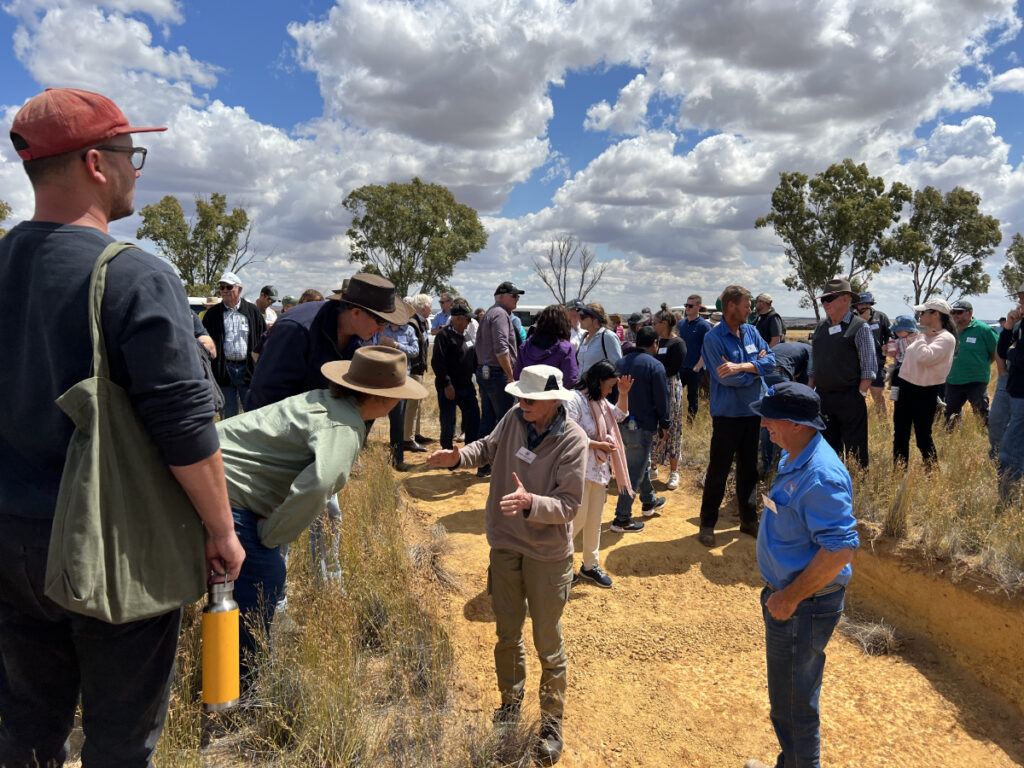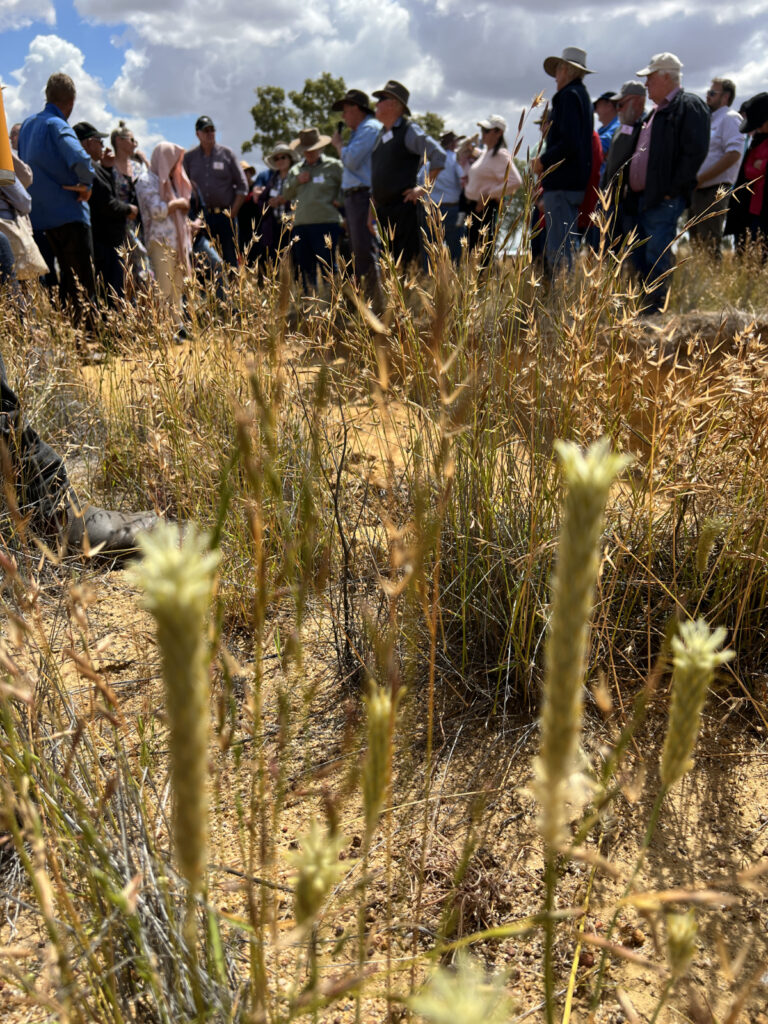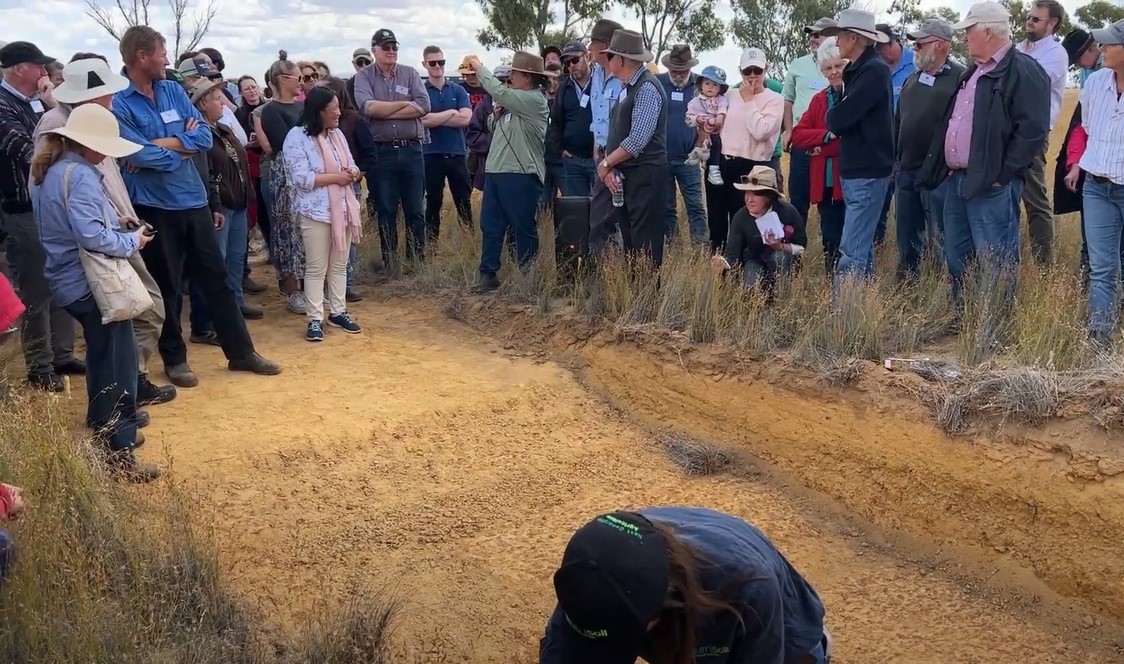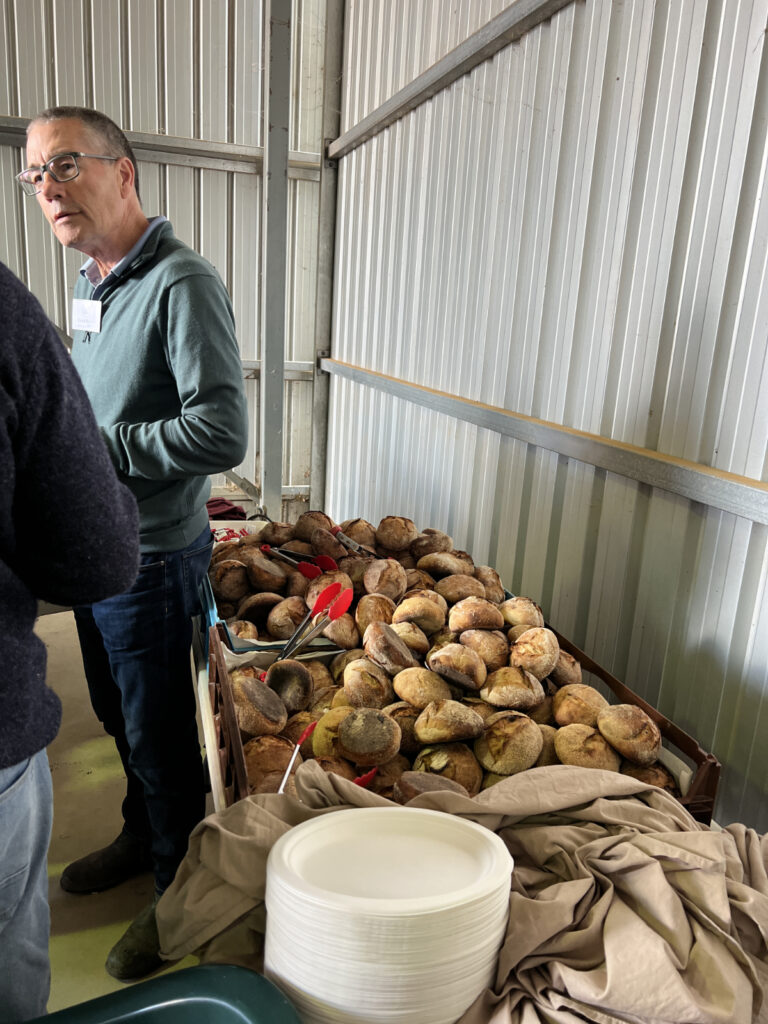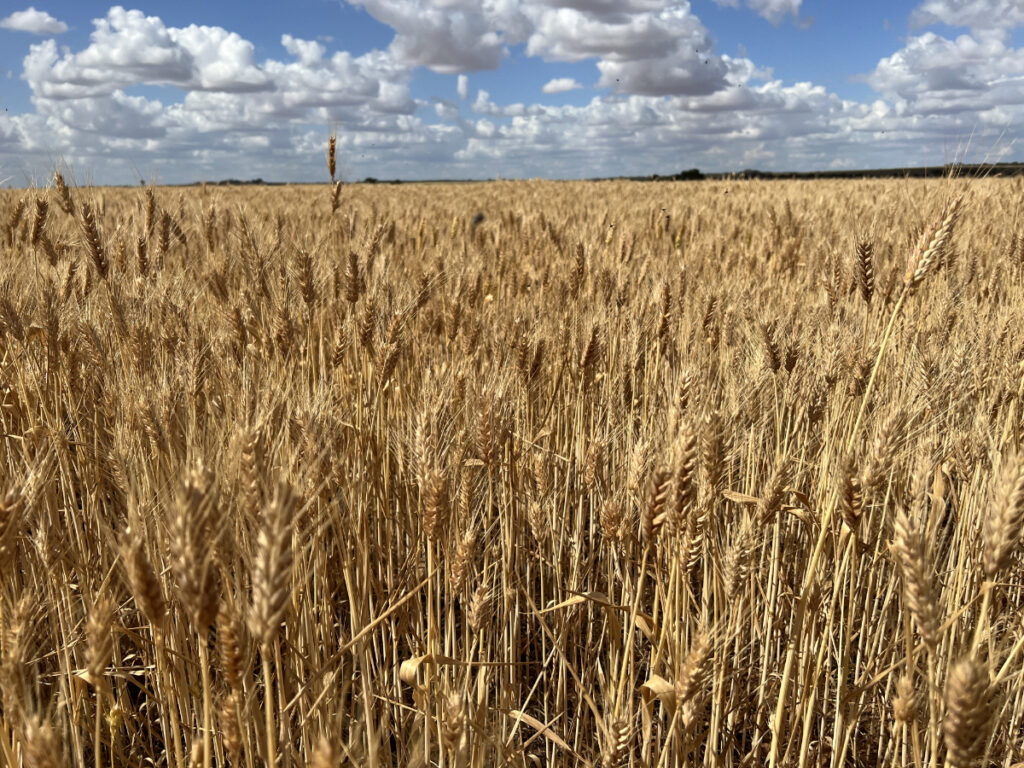Restoring the Western Wheatbelt: an update on Di and Ian Haggerty's case study
Natural intelligence farming | February 2023
Di and Ian Haggerty are world-recognised pioneers in soil and landscape health, and an early Soils for Life case study. Their goal is to produce healthy food and fibre, using modern technology and natural farming.
The Haggertys began 28 years ago with a $100,000 budget and 660 hectares. Today, they have 60,000 acres of cereal cropping and self-replacing sheep.
Di oversees the wool enterprise and Ian the cropping, but they work in concert with their staff to heal each paddock with impressive rates of change.
In October 2022, Di and Ian welcomed 170 people onto their farm for a field day to share their practices of Natural Intelligence Farming for cropping and wool production. The field day gave Soils for Life the opportunity to revisit one of our first cropping case studies, learn about recent practices and how they are building resilience in their landscape.

Field day at Di and Ian Haggerty’s.

Their inspirations
After a moving welcome to Country, the scene for the day was set through a grounding meditation and watching Damon Gameau’s video invitation to tell a new story of the relationship between humans and nature.
Di and Ian then told their farming story. They shared how grateful they are for their time in the Kimberleys with Aboriginal Elders, who ‘took them under their wing’ and showed Di and Ian how to read and be in relation with the landscape, and how to trust their intuition.
Ian also reflected on the influence of Major General Michael Jeffery, Soils for Life’s founder.
Ten years ago, Michael told Ian, ‘the weakest man is one who has knowledge and can make a difference, but doesn’t do anything with it.’
Ian told the audience that Michael’s advice gave them a good dose of motivation to get on with things, even when the sector wasn’t as accepting of their practices.
Other ‘ignition points’ of learning for Di and Ian were Dr. Elaine Ingham, Dr. Arden Anderson, Jane Slattery, Dr. Christine Jones, Walter Jehne, Nicole Masters and Robin Treadwell, the first Australian Rural Woman of the Year.

Di and Ian in conversation with Anthony James during the Natural Intelligence Farming field day.
Natural Intelligence Farming
All of the Haggertys’ decisions are underpinned by Natural Intelligence Farming, a ‘world breakthrough’ according to Charlie Massy.
Developed in partnership over 15 years with Jane Slattery, Natural Intelligence Farming recognises the ability for nature to heal quickly, especially when humans support regenerative relationships between plants, animals, landscapes and themselves.
On the day, Jane Slattery described Natural Intelligence Farming as a process whereby the flow of energy is ‘working first through us as humans, and then through the land’. As part of the practice, each day the human caretakers ask themselves ‘what can we do today to help’. Jane explained how from her perspective, Natural Intelligence Farming is a philosophy of deep humility.
Biological practices
With Natural Intelligence Farming as their broad approach, the Haggertys have continued to develop biological practices. They have not used pesticides for the past 21 years.
Similarly, for the past 18 years, they have not used chemical nitrogen, phosphorus, potassium fertilisers. Instead, the Haggertys focus on what they call ‘no-cost’ nitrogen, made accessible from the air through nitrogen-fixing plants.
They also focus on improving the diversity and complexity of their ‘below ground stock’, e.g. beneficial microbiota (bacterial, fungi, protozoa) and macro-biota (worms, arthopods). Di and Ian include a biological liquid inject when planting with a disk machine and apply a foliar using boom sprays during plant growth to ‘give a boost to the system’.
The volumes used on the field – 3 litres of extract per 10,000 litres as a seed dressing – are relatively small. And, at an estimated $25-35 per hectare and 3-5 cents per litre, they describe their ‘homemade brews’ as ‘very affordable’.
Johnson Su Composting
Johnson Su extract is a large component of their homemade brews. Johnson Su composting creates a locally grown microbial community, or “quorum”, using natural resources on the farm or from neighbours as feedstock.
Currently, the Haggertys have over 30 shuttles, or IBCs, of Johnson Su compost on their property, building an important fungal community to spray over their crops.

Over 30 shuttles of Johnson Su compost at the Haggerty’s main property.
Their Johnson Su compost mix includes one bale of multispecies hay, one bale of barley straw, , and a bucket of sheep poo (gathered from under the shearing shed and which is often already growing fungal hyphae).
They mix these elements using a feed mixer and water, making a challenging physical job much easier, preparing larger quantities at once with little physical effort compared to hand mixing.
Next, the Haggerty team secures six PVC pipes drilled with holes into each shuttle, fill the shuttle with a frontend loader, and move the shuttles under a shed. The PVC pipes allow for aeration of the compost but are removed after several days.
The shuttles are moistened daily with a sprinkler system for a few minutes every day, and hessian sacks laid on top to help maintain moisture of the shuttles that are exposed to sunlight.
Once the composting process is complete, the microbial communities are extracted quickly and added to water as either a seed coat liquid injection or foliar spray.
Typically, the Johnson Su method of composting requires 12 months to mature. However, the Haggertys are inoculating some shuttles with mature Johnson Su compost to see if this increases the speed of composting. The Haggertys are also adding 25 litres of NutriSoil to several shuttles, to observe how this new recipe might stimulate the soil biology differently.


Shuttles of Johnson Su compost. Recently prepared shuttles have PVC pipes to aid oxygenation. Older shuttles, with more composting are covered in hessian sacks.
Making a brew
The Johnson Su plus a good quantity of locally sourced aerated compost provides the living microbial communities to their brew. However, the extract of a Johnson Su compost is not the only ingredient in their seed coatings and foliar sprays.
Nutrisoil (a vermicast), fish and seaweed extracts are also added as diverse bio-stimulants. Nutrisoil has data to verify the microbial life within its produce even with packaging and storing. While these types of products do not always contain microbial life, according to Soils for Life agroecologist, Sarah Fea, the bits of DNA and nutrients within them awaken and grow the microbial community in the soil.
The Haggertys’ primary goal for keeping the ground covered in diverse plants with strong root systems is to build the soil’s capacity as a water and carbon sponge. And, they have observed how these brews encourage the seeds to direct their energy into building root mass. These stronger roots and rhizosheaths help to ‘punch below compaction or chemical layers’.
While the project hasn’t gotten off the ground yet, Di and Ian plan to work with WA’s Department of Primary Industries and Regional Development to acquire new equipment for applying their compost as a liquid slurry, rather than creating only a liquid extract.
Integration of biological cropping and animal stewardship practices
Di and Ian also shared how the integration of biological cropping and animal stewardship practices can lead to incredibly quick changes in their landscape.
In 2020, the Haggertys bought a property that had dry paddocks and a ‘completely broken local water cycle’. Their goal was to get plants growing in the ground as quickly as possible.
They sowed a multispecies cover crop into the ground with a seed coating, applied a foliar spray during growth, crimped the crop into the ground at the end of its growing season, and then lightly grazed with the sheep,
adding their own microbial communities and fertilisers of nutrients and humic acids.
Two years on, the paddock is repopulated with native grasses, where the soil microbiology has been stimulated with the activity of the multispecies they had direct-drilled. ‘It never ceases to amaze me how quickly the landscape can recover’, says Ian.
Ian reiterated, ‘These native grasses are for free, stimulated through adding biologicals down the tube at planting, foliar sprays, and cattle grazing’. And, as Di went on to share, the native grasses play an important role in sheep health.
Regrowth of grasses in a paddock that was completely bare two years ago, and their depth into the soil.
Building resilience in sheep health.
The health of their self-replacing stock is a priority for the Haggertys. They chose a self-replacing process to gain the benefits of a positive epigenetic cycle emerging between the sheep, diverse plants, landscape and soil.
As Di says, the genetic diversity of the soils and plants improves the sheep’s ability to select foods necessary for their health and a healthy gut microbiome. In other words, ‘diverse pastures equal healthy sheep.’ Di and Ian haven’t had to mules or drench the sheep in over 20 years.
Important in their strategy for maximising sheep health through Natural Intelligence Farming is allowing for the sheep to determine what they need. Di shared a story about how she placed 400 ewes in a lush multispecies paddock for a lambing period, thinking this paddock looked most desirable to support their nutritional needs.
However, she left the gate open to the recently regenerated native grains paddock. All 400 ewes chose the native grains paddock to birth, and not a single lamb was lost. ‘You can tell how satisfied the sheep are by how much they sleep during the day’, says Di, ‘and these ewes were resting most of the day.’
Building resilience by improving product value
The Haggertys continue to see improvements in their products. They find their wool is consistently good even in challenging climatic years. With self-selected diets of diverse pasture plants and improved genetic and microbiotic relations between their self-replacing herd and the landscape, they find that the quality of their wool has increasingly finer microns. They have recently entered a relationship with NATIVA wool, a high-end European wool company, which is supporting the farmers who are regenerating
soils and landscapes through wool production.
On the cropping side, they started a relationship with a stone ground baker in Perth. Not only does this spread their regenerative story locally, but it also helps get the nutritious grains to the community as quickly as possible. For the field day, the baker received grains on Sunday, ground them, baked bread rolls and delivered on Monday, ensuring very little time for their nutritional benefit to decrease.
Haggertys’ wheat turned into bread rolls by a local baker for the field day.
Building resilience in soils, landscapes and finances soil cores
The Haggertys continue to see improvements in the resilience of their soils and landscapes, as well as personal and financial resilience.
Through ongoing studies of their soils, they see on average five times less acid without having to apply lime. They calculate an extra 800 kg of nitrogen in their soil per hectare, without any fertiliser. They are also seeing a significant water recharge, with a 13% increase in soil water and a fresh-water lens developing on some of the landscape.
They are also thankful for their ability to continue to produce in increasingly unpredictable weather patterns. They used to have ‘eight good seasons out of every ten’. Now they feel it is closer to ‘two good seasons out of every ten’. Even so, in three recent years of 100ml rain total per year, they’ve still been able to maintain groundcover. Some of their greatest moments of joy are seeing the endangered species return.
In terms of financial resilience, Ian emphasised how avoiding fungicides, pesticides and fertilisers for almost 20 years has been a significant cost saver. Their five-year average operating efficiency is 56.4%. A good number here is considered to be below 65%.
Building resilience beyond the property boundaries.
While Di and Ian are trying to do all they can to steward their own landscapes towards improved health, they also recognise that the health of their farms are dependent on the health of the entire ecosystems in which they are embedded. Thus, the Haggertys have been fortunate to extend their operation to conjoined land, and land that adjoins revegetation programs to assist with influencing larger water cycles, and thus bacterial movement, across their catchment.
Di and Ian are upfront about the long hours they’ve had, and the challenging lessons, but even so, they wouldn’t change a thing. When asked about advice for others, Ian said ‘If we can do it here in a semi-arid location, anyone can do it. But go with 100% commitment to whatever you do.’ And Di added for those interested in Natural Intelligence Farming, ‘stop thinking and start connecting through the heart’.
Further reading
Read more about the Haggertys case study here. Find out more about Di and Ian Haggerty’s Natural Intelligence Farming here.




